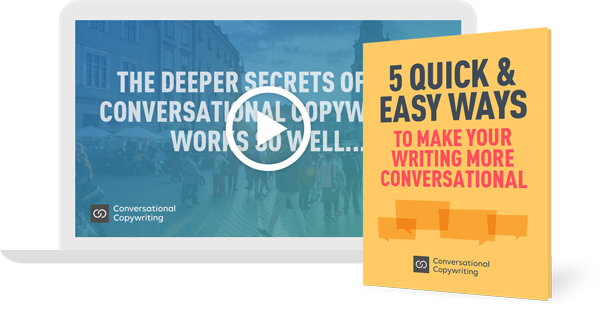
I’m the first to admit it.
I’m not the world’s greatest listener.
I tend to talk more than listen. I have the bad habit of waiting impatiently for the other person to stop talking, so I can carry on saying what I want to say.
I’m not that bad all the time. I’m making a conscious effort to shut up and really, truly listen.
And I’m getting better, I think.
Any improvements I’m making are more than likely a result of my obsession with conversational writing and copywriting.
The more I dig into the craft of conversational copywriting, the more I learn about the power of conversation itself.
And the more I read and think about the power of conversation, the more I recognise that the foundations of great conversations are built on our ability and willingness to listen.
In other words, if you want to be a good writer, copywriter or conversationalist, you’d better hone your listening skills first.
Here’s how you can do that, in three easy steps.
Step 1: Listen before you write. And keep listening.
Too many companies and entrepreneurs pay lip service to the idea of listening to their prospects and customers.
But all too often, it’s just that… lip service.
They do market research and focus groups. They mine big data sets.
They listen as if it were a science project.
That’s not listening at all.
Where can you listen and learn the language of your audience? That’s easy. Though social media, blog comment streams, reviews on Amazon, Yelp and other sites and platforms.
Online there’s no end of places to discover the true voices and emotions of your prospects and customers.
Forget the data sets. Listen to the voices.
Step 2: Mirror the language of your readers when you write.
The best way to let people know you’re really listening to what they say is to mirror their language.
Talk back – or write back – using some of the same words and phrases.
The simple act of repeating a few of the words they just used shows you’ve been paying attention, that you’ve been listening.
You can mirror people’s emotions too. Do that and you’re demonstrating empathy, letting them know you understand their point of view. You get where they’re coming from.
The more you listen, the more you can mirror. And the more you mirror, the more likely it is that your audience will pay attention to what you’re saying.
Step 3: Write like you’re there, as a person. Not like a marketer.
When you write in the language of a clever marketer, you’re creating distance. You’re writing from on high. You’re writing AT your readers.
That’s no way to be conversational.
Put aside your fancy writing skills. Stop writing like a highly trained marketer or business expert.
Write like you’re talking with a friend over coffee.
And if you’re ever in any doubt about whether you sound like a person or like a marketer, just read your copy out loud.
How does it sound? Natural and honest? Or carefully constructed and sneaky?
When you write like a listener, you set yourself apart.
Most copywriters and business owners write like marketers.
Or they fall back on fancy business writing.
Both approaches create distance between you and your readers.
But when you begin by listening, everything changes.
Listen carefully and you’ll get important cues on the language you should be using.
Then simply relax, and write as if you were writing an enthusiastic letter to a friend or neighbor.
Keep it simple. Keep it natural.
Be persuasive, but in your own, conversational voice.
NOTE: Find out more about learning the craft of conversational copywriting…

My favourite takeaway was from the email inviting me to this reading: “Before joining any conversation, you’d do well to listen to people first.”
So often in social communication I only get as far as my introductory sentence (or phrase) before listeners grab the ball and run off the court with it, never pausing to wonder where I’d intended throwing it. I’m trying to think up ways to put this unwanted skill to good copywriting use 🙂
How to write like a good listener in three easy steps….
Nick, you need to know your audience….how they think, talk and what they are interested in….to name a few things. Make sure they not only hear you but are they are listening to you.
Sage advice Mr. Usborne. Not enough people truly listen and engage in meaningful chat. I find that if I ask questions during a conversation with friends and coworkers helps as well. It not only shows I am an active participant in the conversation, but questions help me remember interesting snippets. And these are always a great to start another conversation or a chance to continue the conversation down the road. You have to truly listen to ask good questions.